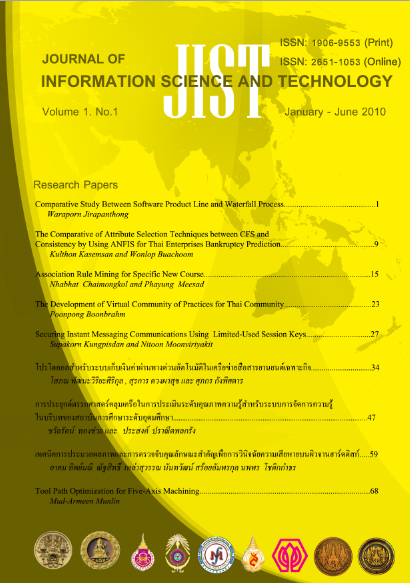The Comparative of Attribute Selection Techniques between CFS and Consistency by Using ANFIS for Thai Enterprises Bankruptcy Prediction
Main Article Content
Abstract
- This paper presents the comparison of attribute selection techniques between CFS and Consistency for seeking better technique which could appropriately associate with ANFIS. Better model will be used for predicting business bankruptcy in Thai enterprises. According the objective of this study, there are two prediction models, CFS-ANFIS and Consistency-ANFIS. Type 1 error from estimation, which effect to stakeholders’ decision making, is used for consider each model. The result indicates that estimation error rates obtained from CFS-ANFIS are lower than the error rates obtained from Consistency-ANFIS.
Article Details
This work is licensed under a Creative Commons Attribution-NonCommercial-NoDerivatives 4.0 International License.
I/we certify that I/we have participated sufficiently in the intellectual content, conception and design of this work or the analysis and interpretation of the data (when applicable), as well as the writing of the manuscript, to take public responsibility for it and have agreed to have my/our name listed as a contributor. I/we believe the manuscript represents valid work. Neither this manuscript nor one with substantially similar content under my/our authorship has been published or is being considered for publication elsewhere, except as described in the covering letter. I/we certify that all the data collected during the study is presented in this manuscript and no data from the study has been or will be published separately. I/we attest that, if requested by the editors, I/we will provide the data/information or will cooperate fully in obtaining and providing the data/information on which the manuscript is based, for examination by the editors or their assignees. Financial interests, direct or indirect, that exist or may be perceived to exist for individual contributors in connection with the content of this paper have been disclosed in the cover letter. Sources of outside support of the project are named in the cover letter.
I/We hereby transfer(s), assign(s), or otherwise convey(s) all copyright ownership, including any and all rights incidental thereto, exclusively to the Journal, in the event that such work is published by the Journal. The Journal shall own the work, including 1) copyright; 2) the right to grant permission to republish the article in whole or in part, with or without fee; 3) the right to produce preprints or reprints and translate into languages other than English for sale or free distribution; and 4) the right to republish the work in a collection of articles in any other mechanical or electronic format.
We give the rights to the corresponding author to make necessary changes as per the request of the journal, do the rest of the correspondence on our behalf and he/she will act as the guarantor for the manuscript on our behalf.
All persons who have made substantial contributions to the work reported in the manuscript, but who are not contributors, are named in the Acknowledgment and have given me/us their written permission to be named. If I/we do not include an Acknowledgment that means I/we have not received substantial contributions from non-contributors and no contributor has been omitted.
References
2. Altman, Edward I. “Financial Ratios Discriminant Analysis and The Prediction of Corporate Bankruptcy”. The journal of Finance. 4 (1968) : 589-609.
3. Huang Fu-yuan. “A Genetic Fuzzy Neural Network for Bankruptcy Prediction in Chinese Corporations”. Proceeding of the 2008 International Conference on Risk Management & Engineering Management. IEEE Computer Society, 2008.
4. Tong Srikhacha. “Short-Term Prediction in Stock Price Using Hybrid Optimized Recursive Slope Filtering, Adaptive Moving Approach and Neurofuzzy Adaptive Learning”. PhD thesis, Department of Information Technology, King Mongkut’s Institute of Technology North Bangkok,Thailand, 2007.
5. Borges, Helyane B. and Nievola, Julio C. “Attribute Selection Methods Comparison for Classification of Diffuse Large B-Cell Lymphoma”. Proceedings of the Fourth International Conference on Machine Learning and Applications. IEEE Computer Society, 2005.
6. Hall, Mark A. and Holmes, Geoffrey. “Benchmarking Attribute Selection Techniques for Discrete Class Data Mining”. IEEE Trans on Knowledge and Data Engineering. 15 (2003) : 1437-1447.
7. Sukontip Wongpun and Anongnart Srivihok. “Comparison of Attribute Selection Techniques and Algorithms in Classifying Bad Behaviors of Vocational Education Students”. Proceedings of 2008 Second IEEE International Conference on Digital Ecosystems and Technologies. IEEE Computer Society, 2008.
8. Sukontip Wongpun. “Comparison of Attribute Selection Techniques and Algorithms in Classifying Mistaken Behaviors of Vocational Education Students”. Master of Science thesis, Department of Computer Science, Kasetsart University, Thailand, 2008.
9. Jang, J. S., Sun, C.T. and Mizutani, E. Neuro-Fuzzy and Soft Computing : A Computational Approach to Learning and Machine Intelligence. n.p. : Prentice-Hall, 1997.
10. Jang, S. R. “ANFIS: Adaptive-Network-Based Fuzzy Inference System”. IEEE Trans. System, Man and Cybernetic. 23 (1993) : 665-684.
11. Gibson, Charles H. Financial Reporting and Analysis. Ohio : Thomson South-western, 2007.
12. Stickney, Clyde P. Financial Reporting and Statement Analysis.Texas:The Dryden Press, 1996.
13. Walsh Ciaran. Key Management Ratios The Clearest Guide to The Critical Numbers That Drive Your Business. Pearson Education, 2006.


